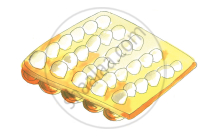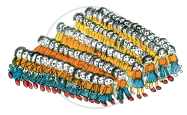Advertisements
Advertisements
प्रश्न
| 9 × 1 = 9 | |
| 9 × 2 = 18 | 1 + 8 = 9 |
| 9 × 3 = 27 | 2 + 7 = 9 |
| 9 × 4 = 36 | 3 + 6 = 9 |
| 9 × 5 = 45 | 4 + 5 = 9 |
| 9 × ______ = ______ | ______ + ______ = ______ |
| 9 × ______ = ______ | ______ + ______ = ______ |
| 9 × 8 = ______ | ______ + ______ = ______ |
Did you see the pattern in the 9 times table? What numbers are adding up to 9?
उत्तर
| 9 × 1 = 9 | |
| 9 × 2 = 18 | 1 + 8 = 9 |
| 9 × 3 = 27 | 2 + 7 = 9 |
| 9 × 4 = 36 | 3 + 6 = 9 |
| 9 × 5 = 45 | 4 + 5 = 9 |
| 9 × 6 = 54 | 5 + 4 = 9 |
| 9 × 7 = 63 | 6 + 3 = 9 |
| 9 × 8 = 72 | 7 + 2 = 9 |
APPEARS IN
संबंधित प्रश्न
So how many legs altogether do 5 octopuses have?
______ + ______ + ______ + ______ + ______ = ______
or 5 times ______ = ______
or 5 × ______ = ______

How many eggs?
______ times ______ = ______ eggs

Tell how many times!
2 + 2 + 2 + 2 + 2 = ______ × ______ = ______
Look at the patterns and complete them.
4, 8, 12, ______, ______, ______.
Look at the patterns and complete them.
5, 10, 15, ______, ______, ______.
Some multiplication facts:
______ × ______ = 42
In a picnic 4 fruits were given to every student. The number of students was 23. Find out the total number of fruits given.
Multiply:
11 × 5 =
Multiply:
26 × 4 =
First guess the answer and then calculate:

Students stand in rows in the assembly. There are six rows of students. Each row has 17 students. How many students are there?
